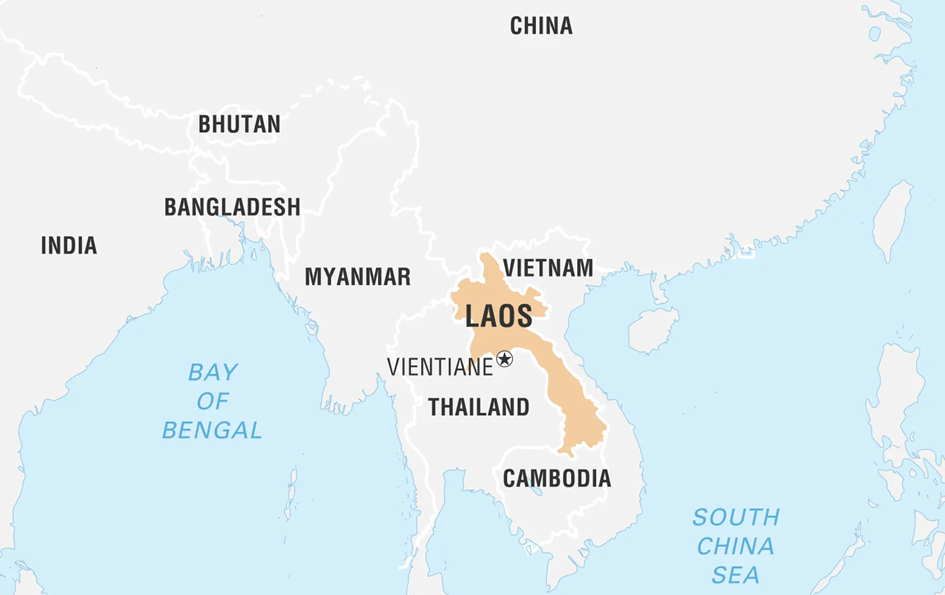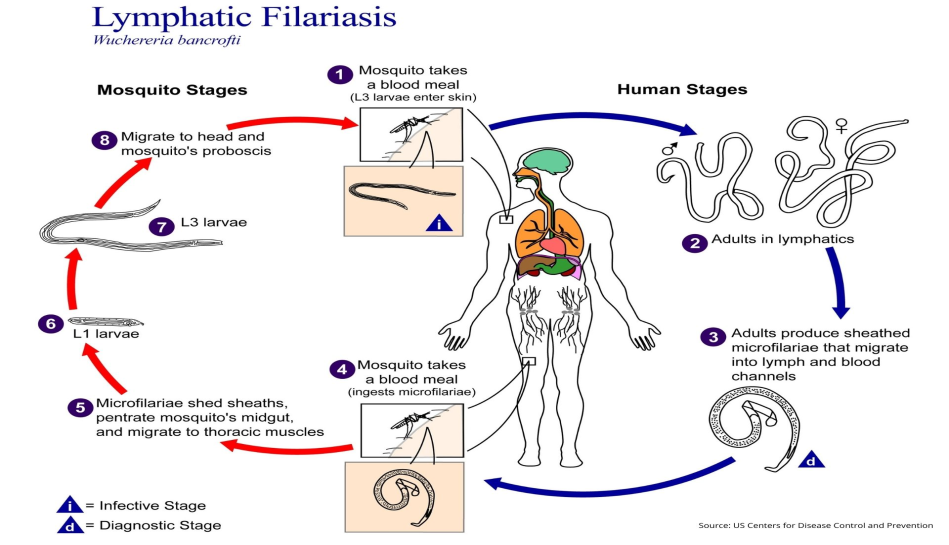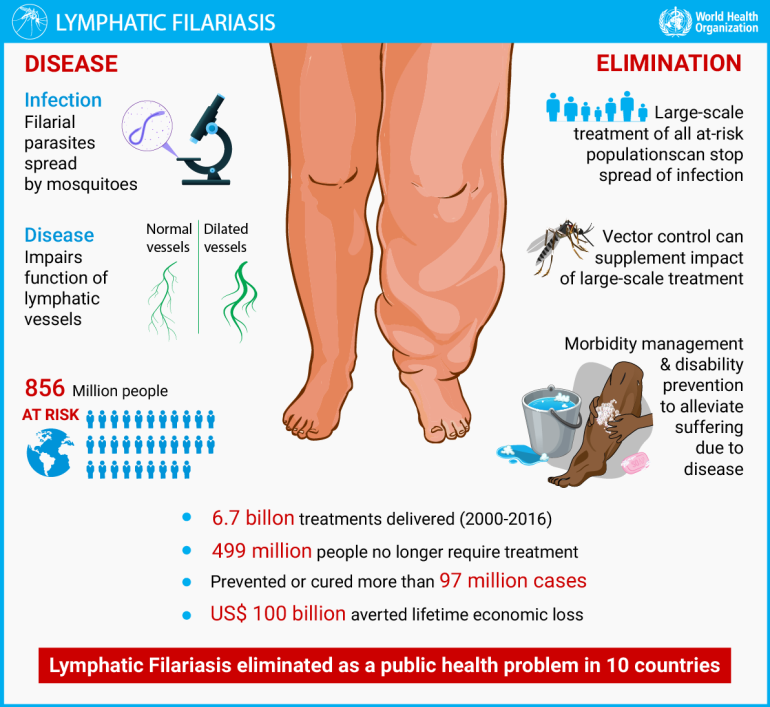LAO PDR ELIMINATES LYMPHATIC FILARIASIS

Copyright infringement not intended
Picture Courtesy: www.britannica.com
Context: The Lao People’s Democratic Republic has successfully eliminated lymphatic filariasis (LF) as confirmed by the World Health Organization (WHO).
Details
- Lao PDR has successfully eliminated lymphatic filariasis (LF), a debilitating disease, making it the second country after Bangladesh to achieve this feat in 2023.
- Prior to eliminating LF, Lao PDR also eliminated trachoma as a public health hazard in 2017.
- The elimination of LF in Lao PDR is attributed to decades of hard work by the government, healthcare workers, communities, and national and international partners.
|
Global Progress on LF Elimination |
●19 countries, including Lao PDR, have eliminated LF according to the World Health Organization (WHO) progress report released on October 13, 2023. ●Among these countries, 11 belong to the WHO Western Pacific Region (WPR), and Lao PDR is the 11th country in this region to successfully eliminate LF. ●Apart from the Western Pacific Region, LF has been eliminated in Southeast Asia (Bangladesh, the Maldives, Sri Lanka, and Thailand), Africa (Malawi and Togo), and the Eastern Mediterranean (Yemen). |
|
Method of Elimination |
●Mass drug administration (MDA) is the most cost-effective method for treating LF in endemic areas and stopping its transmission. ●WHO recommends a triple therapy combination of ivermectin, diethylcarbamazine, and albendazole for MDA against LF. ●Multiple rounds of MDA, covering over 65% of the population, are required. |
|
Global Efforts and Challenges |
●Efforts under the Global Programme to Eliminate Lymphatic Filariasis, launched in 2000, have significantly reduced the global population requiring LF interventions by 53% over the last 15 years. ●Despite progress, challenges remain. In 2022, 794 million people globally required MDA for LF treatment, with India having the highest number of individuals in need. ●While some countries have stopped MDA nationally, they are yet to meet the validation criteria. Kenya is making progress towards LF elimination. ●Gabon in Africa has not yet begun MDA efforts for LF elimination. |
|
Global Sustainable Development Goal |
●The elimination of Neglected Tropical Diseases (NTDs), including LF, by 2030 is a primary objective of the United Nations-mandated global sustainable development goal of "health for all" (SDG 3). ●The achievement of LF elimination in Lao PDR serves as an example for other countries and contributes to the global goal of ensuring health for all. |
Lymphatic Filariasis (LF)
- Lymphatic Filariasis (LF), commonly known as elephantiasis, is a neglected tropical disease caused by parasitic worms transmitted to humans through the bites of infected mosquitoes.
- Neglected tropical diseases (NTDs) are a group of diseases that are common in low-income populations in developing regions of Africa, Asia, and the Americas. They are caused by a variety of pathogens, such as viruses, bacteria, protozoa, and parasitic worms (helminths).
- NTDs are often neglected because they do not receive the same attention as other diseases, such as HIV/AIDS and malaria. However, NTDs can have a devastating impact on people's lives, causing disfigurement, disability, and death.
- It is a major public health concern in many parts of the world, particularly in tropical and subtropical regions.
- It is caused by three species of parasitic worms: Wuchereria bancrofti, Brugia malayi, and Brugia timori. These worms lodge in the lymphatic system, leading to inflammation and blockages in the lymphatic vessels.
Transmission
- Mosquitoes, particularly Culex, Anopheles, and Aedes species, serve as vectors transmitting the infective larvae from person to person.
- The larvae mature into adult worms in the lymphatic system, perpetuating the infection cycle.
Symptoms and Clinical Manifestations
- Acute attacks of fever, pain, and swelling in the affected limbs.
- Chronic conditions often lead to severe disfigurement, disability, and social stigma.

Impact of Lymphatic Filariasis
|
Individual and Social Consequences |
●Physical disabilities and reduced quality of life. ●Stigmatization and discrimination, lead to social isolation. ●Economic burden due to reduced productivity and healthcare costs. |
|
Community-Level Impact |
●LF perpetuates the cycle of poverty in affected communities. ●Impaired workforce productivity affects economic development. ●Strains healthcare systems and resources. |
Challenges in Prevention and Treatment
|
Diagnosis |
●Limited access to accurate diagnostic tools, delaying timely treatment. ●Challenges in diagnosing early stages of the disease. |
|
Preventive Measures |
●Mass drug administration (MDA) programs face difficulties in reaching remote and marginalized communities. ●Compliance issues and the need for sustained, long-term interventions. |
|
Treatment and Management |
●Limited availability of effective drugs. ●Challenges in managing advanced cases and preventing disability progression. ●Lack of awareness and education about LF in endemic regions. |

Global Efforts to Eliminate Lymphatic Filariasis
|
World Health Organization (WHO) Initiatives |
●WHO’s Global Programme to Eliminate Lymphatic Filariasis (GPELF) was launched in 2000. ● MDA campaigns: Distribution of antifilarial drugs to at-risk populations. ●Advancements in research for better diagnostic tools and treatments. |
|
Collaborative Partnerships |
●Partnerships between governments, non-governmental organizations (NGOs), and pharmaceutical companies. ●Donor support and funding for LF elimination programs. |
Conclusion
- Significant progress has been made in the fight against lymphatic filariasis (LF) through global initiatives and collaborative efforts, with the potential to ultimately eradicate LF and relieve millions from its burden.
Must Read Articles:
Lymphatic Filariasis: https://www.iasgyan.in/daily-current-affairs/lymphatic-filariasis-40#:~:text=Filariasis%20is%20a%20disease%20caused,and%20disability%20behind%20leprosy%20worldwide.
Lymphatic Filariasis: https://www.iasgyan.in/daily-current-affairs/lymphatic-filariasis
|
PRACTICE QUESTION Q. What impact does the World Health Organization (WHO) have on global healthcare policies and disease control strategies, and how has its role evolved in response to recent global health challenges? |



1.png)
